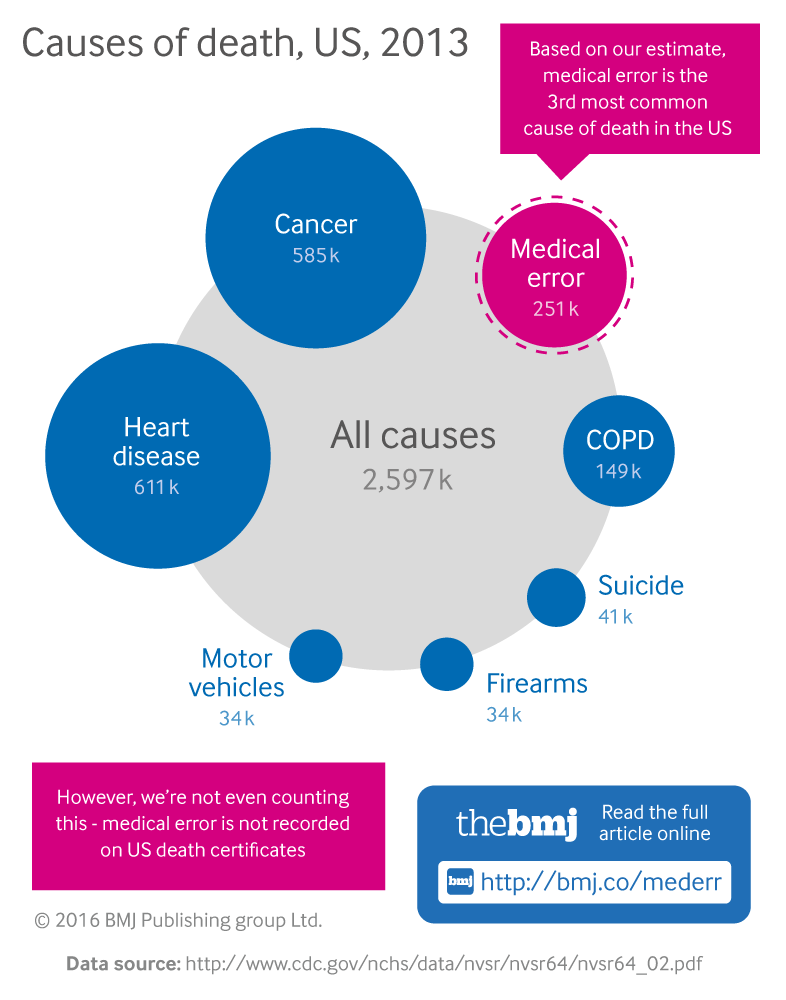Media Covers May BMJ Article: “Medical Error 3rd Leading Cause of Death in U.S.” – Call for New Hashtag #SimToZero!
Earlier this month the BMJ published a study by medical researchers from John Hopkins which provided a deeper analysis into the 2014 Journal of Patient Safety. Check out more about the new article here, and listen to this BMJ Podcast interview about the research:
About the Analysis:
Sponsored Content:
Analyzing medical death rate data over an eight-year period, Johns Hopkins patient safety experts have calculated that more than 250,000 deaths per year are due to medical error in the U.S. Their figure, published May 3 in The BMJ, surpasses the U.S. Centers for Disease Control and Prevention’s third leading cause of death—respiratory disease, which kills close to 150,000 people per year. The Johns Hopkins team says the CDC’s way of collecting national health statistics fails to classify medical errors separately on the death certificate.
The researchers are advocating for updated criteria for classifying deaths on death certificates. “Incidence rates for deaths directly attributable to medical care gone awry haven’t been recognized in any standardized method for collecting national statistics,” says Martin Makary, professor of surgery at the Johns Hopkins University School of Medicine and an authority on health reform. “The medical coding system was designed to maximize billing for physician services, not to collect national health statistics, as it is currently being used.”
This publication really caught a lot of media attention:
- CBS News – “For the study, Makary and his colleagues evaluated four separate studies that analyzed medical death rate data from 2000 to 2008, including one by the U.S. Department of Health and Human Services’ Office of the Inspector General and the Agency for Healthcare Research and Quality. Based on 2013 data on hospitalization rates, they found that of 35,416,020 hospitalizations, 251,454 deaths stemmed from a medical error. They said that adds up to 9.5 percent of all deaths a year in the U.S.”
- Huffington Post – “Unfortunately, this news is not surprising at all. In the medical community, we have seen the consequences of inaccurate diagnoses and medical error for quite some time. While concrete efforts have been made to correct wrong site surgeries and other well publicized issues from the past, not enough has been done to address medical error that results from an incomplete or inaccurate diagnosis. 37% of the cases we review require a change in diagnosis, and over 75% of cases require a change in treatment plan.”
- CNN – “One reason there’s such a wide range of numbers is because accurate data on these kinds of deaths is surprisingly sparse. That’s in part because death certificates don’t ask for enough data, Makary said. Currently the cause of death listed on the certificate has to line up with an insurance billing code. Those codes do not adequately capture human error or system factors.”
- Washington Post – ““There has just been a higher degree of tolerance for variability in practice than you would see in other industries,” he explained. When passengers get on a plane, there’s a standard way attendants move around, talk to them and prepare them for flight, Sands said, yet such standardization isn’t seen at hospitals. That makes it tricky to figure out where errors are occurring and how to fix them. The government should work with institutions to try to find ways improve on this situation, he said.”
Additional press Coverage spread wide and far…
Sponsored Content:
- ABC News
- BigThink
- MintPress
- Indiana Public Media
- News Talk Florida
- CNS News
- San Diego Union Tribune
- Science Alert
- And many more…
Unfortunately, many of the articles did NOT cover potential solutions for addressing these avoidable mistakes. As champions of Simulation, we must reach out to these media agencies and remind them that healthcare simulation provides a huge opportunity to better educate and train for improved patient safety outcomes.
With this rare opportunity to maximize such exposure, I encourage you to write in and tweet these media agencies and remind them that simulation is already helping to address many of these problems with the hashtag #SimToZero, highlighting a goal to reduce medical errors to zero through the use of healthcare simulation.
Please join me in this new campaign to create a hashtag supporting
Simulation To Zero Patient Deaths From Medical Error!
Lance Baily, BA, EMT-B, is the Founder & CEO of HealthySimulation.com, which he started while serving as the Director of the Nevada System of Higher Education’s Clinical Simulation Center of Las Vegas back in 2010. Lance is also the Founder and acting Advisor to the Board of SimGHOSTS.org, the world’s only non-profit organization dedicated to supporting professionals operating healthcare simulation technologies. His co-edited Book: “Comprehensive Healthcare Simulation: Operations, Technology, and Innovative Practice” is cited as a key source for professional certification in the industry. Lance’s background also includes serving as a Simulation Technology Specialist for the LA Community College District, EMS fire fighting, Hollywood movie production, rescue diving, and global travel. He and his wife Abigail Baily, PhD live in Las Vegas, Nevada with their two amazing daughters.
Sponsored Content:




















